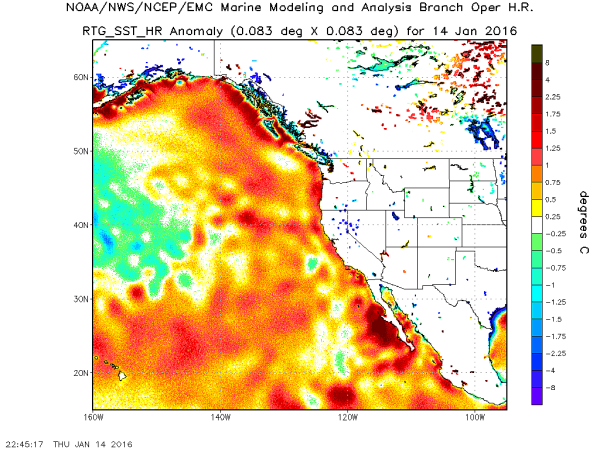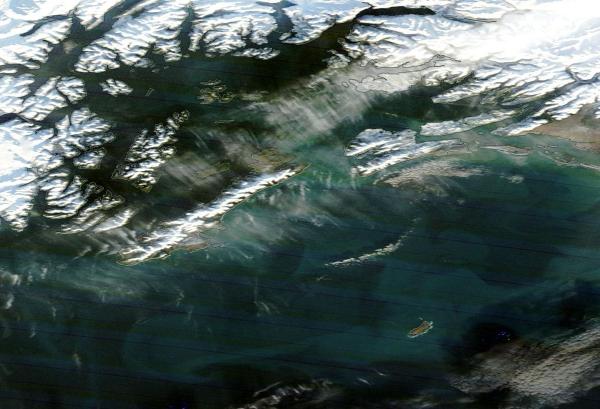I will say it before someone shouts out "what about Fukushima?!" - I do not think this is the only game in town. Radiation buildup in the food chain caused by bio accumulation is definately a suspect causative factor.
Reducing
everything to one cause is crazy. We live in a complex world.
Did The Human-Warmed Ocean Just Kill 8,000 Murres?
15
January, 2015
Around
the world, mass sea creature die-offs have been occurring at an
alarming rate. Off the US West Coast alone, the past three years have
seen severe losses along almost ever link of the marine food chain
from sea stars, to salps, to crabs, to sea lions. Many of these
deaths have been linked directly or indirectly to impacts caused by a
chronic warming of the region’s ocean surface dubbed ‘the hot
blob.’
Now,
a tragic and heart-wrenching new die-off has been recorded in the
region of Prince William Sound. There, according
to recent reports in the Washington Post,
more than 8,000 murres — a kind of deep-swimming sea bird — were
found dead. Washed up on shore, the mures bodies were shrunken and
emaciated. Their stomachs completely empty of food.
Researchers
noted that the mass death was likely due to starvation. But the
potential cause given for the starvation was rather more ominous.
The
Link to Human Warming of the World Ocean
Mures
feed on small fish that swim within the top 300 feet of the ocean
surface. The graceful murres ride the airs above the water until they
catch sight of a school of these fish. Swooping in from above, the
mures plunge toward their prey, snaring them with rapier-quick
thrusts of their beaks.
Such
fish usually swim close to the coast — thriving in the cold,
nutrient-rich waters off Prince William Sound. But warm the waters up
by just a little and the fish may leave — following their own food
supply into colder regions.
(The
hot blob still holds sway over the Northeastern Pacific. This despite
a series of strong El Nino storms and a somewhat flattening of the
Jet Stream. It’s an extreme ocean warming that has been ongoing for
more than two years. One that’s been linked to the mass deaths of
numerous marine creatures. Image source: The
National Weather Service.)
And
the waters near and around Prince William Sound have been much warmer
than normal during recent years. As of January 14th, 2016, sea
surface temperatures in the region have ranged from 1 to 4 degrees
Celsius above average. Extremely high differentials for an ocean
surface that, during the Holocene, rarely varied by more than 1 or 2
degrees from typical ranges.
This
extreme Northeastern Pacific warming is but an aspect of a larger
heating trend ongoing in the global ocean system due to a rampant
human emission of greenhouse gasses. This massive burning of fossil
fuel has dumped hundreds of billions of tons of carbon into the
world’s atmospheres and oceans — setting off a raging greenhouse
effect and causing the Earth surface to warm by more than 1 degree
Celsius above 1880s levels. It may not sound like much, but 1 C is
just 1/4 the difference between now and the last ice age — but on
the side of hot. And this 1 C warming happened in just 130 years
where at the end of the last ice age the same amount of warming would
have taken 25 centuries.
A
Hothouse Dead Zone For Prince William Sound?
To
the oceans and to the innocent creatures that live within, upon and
above it, such a rapid accumulation of heat is a brutal insult. It
removes whole habitats. It forces sea creatures to change their
patterns of migration. It makes the surface waters more suitable for
the kinds of dangerous algae blooms that produce ocean dead zones.
Zones of low or zero oxygen in which very few forms of life can
survive.
(Prince
William Sound dead zone visible in this December 6, 2015 satellite
shot? Tell-tale greens and blues hint that a large algae bloom may be
robbing the waters around the sound of much needed nutrients and
oxygen. A kind of new deadly ocean environment that is proliferating
as sea surface temperatures warm into ranges in which dead zone
producing microbes can thrive. Image source: LANCE
MODIS.)
And
it’s this kind of generation of an ocean killing field that is
perhaps the most brutal and terrifying aspect of what we’ve already
done to our planet. What the legacy of our fossil fuel carbon
emissions will continue to do for decades to centuries to, perhaps,
millennia.
And
sadly, looking at the NASA MODIS satellite data, we do see an
indication of the kind of algae bloom that may be depleting the
waters near Prince William Sound of that life-giving oxygen. We see
the tell-tale greens and blues of a large bloom of the kind that can
rob waters both of nutrients to support fish life and of oxygen
itself. Visual analysis alone cannot positively identify this kind of
bloom with 100 percent certainty. Water samples must be taken in the
area and analyzed. But scientists asking the very pertinent question
— did global warming cause this? — may only need to take a look
at the composition of this bloom to get their answer.
An
answer that won’t save the thousands of already dead murres, but
that might help us build the resolve to prevent more catastrophes
like this one. To stop burning fossil fuels and halt the accumulation
of a terrible build-up of heat forcing that is ripping the very
underpinnings of life in the oceans asunder.
Links:
Hat
Tip to Colorado Bob





No comments:
Post a Comment
Note: only a member of this blog may post a comment.